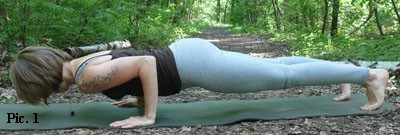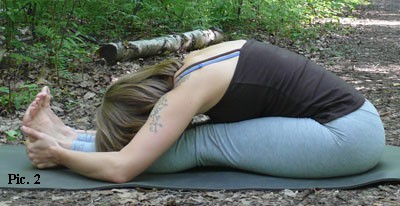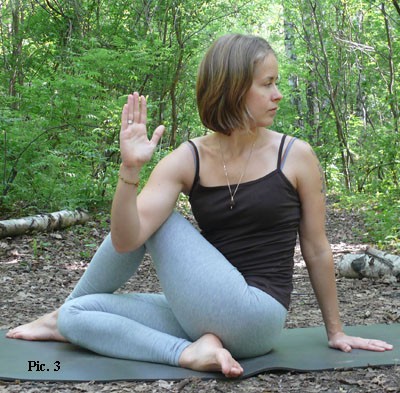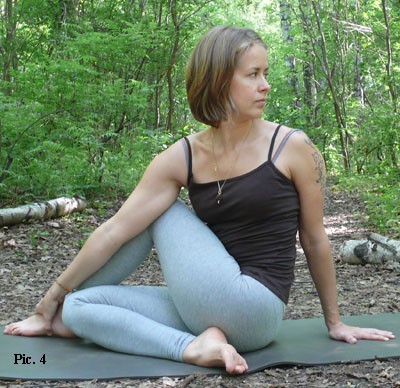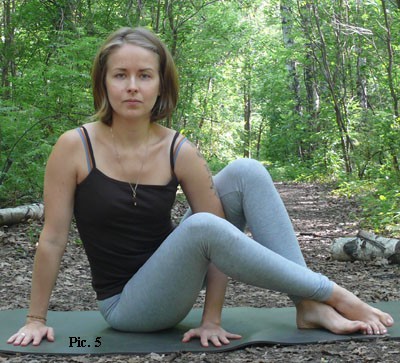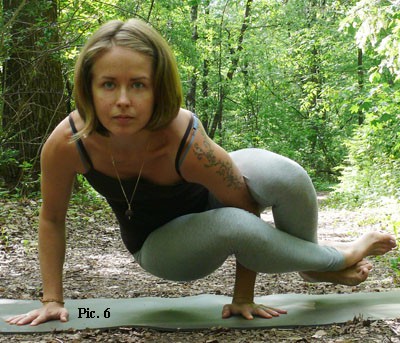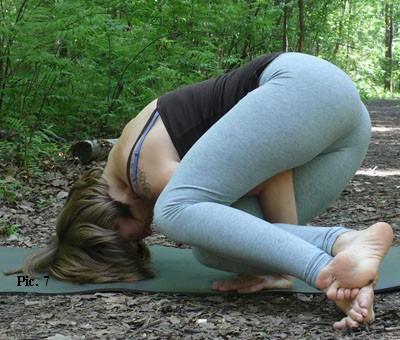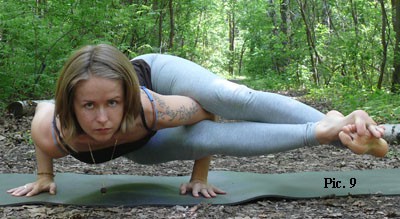It's not a secret that the main thing in yoga practice is your own inner work, awareness of everything that happens inside while one's body performs this or that posture. But it's always interesting to see what the others can do with their bodies. Almost every practitioner surfs the vast Internet space and looks through the photos of different yoga teachers. Some people evaluate their own abilities – “I'll accomplish this posture in 3 years, this one - in 7, and this one is in fact unachievable.” Usually the most desirable and delightful are so called “power” postures, different balances – Astavakrasana, Kaundinyasana and so on.
With the lapse of time there comes an understanding that muscular and tendon strength do not play the main role here. That's why in most traditional yoga schools these postures are called in a more modest way – simply balances.
I very well imagine that some ladies and even some gentlemen can say, this is not a proper posture for women, only a few can accomplish it, it's bad to strain yourself, and so on. But the truth is that these postures are an essential part of yoga practice. You can't always do only what is pleasant and easy. If you will only relax and stretch you can't talk about a balanced practice, such imbalance will always end as a trauma. For better development a human being needs to learn, how to overcome challenges, of course those within one's powers. Self-perfection and overcoming of weaknesses is one of the most important goals of yoga practice.
Ashtavakrasana is one of the most simple and useful postures, it strengthens wrists, back and abdominal muscles. All difficult balance asanas begin with it. When you will understand the principle of building this posture, all other balances become a question of time.
There is a very special legend connected with this asana. In ancient times there lived a sage named Kagola. He cursed his son because this child prodigy, being in his mother’s womb, heard that his father made some mistakes while reciting Vedic texts and laughed. As a result he was born as Ashtavakra – a man who was bended in eight body spots. But anyway he became a great scholar and when he was a very young man, he defeated one of the greatest Pandits – Vandi, and was appointed king's Counsellor. His father was so taken by this event that he blessed his offspring and he suddenly became a beautiful and slender young man. We can reflect upon interesting habits and customs of ancient sages for a long time but we have the Ashtavakrasana before us, so let's proceed.
We have already decided that it is a balance posture, but of course you need some strength to raise your body from the floor. That's why you have to begin with Chaturanga Dandasana. I perfectly understand that most beginners don't like it, especially women. I can repeat thousand times about its benefits but still they try their best to skip it. In this case I have bad news for you – if you will not learn how to perform this posture, you can forget about all other more or less difficult “power” asanas. This boring posture is the key one for controlling your body.
What is the balance?
You don't need any phenomenal strength or flexibility for it. The main thing is to feel that very spot in which you can easily hold your posture. The best way to learn it - is Chaturanga Dandasana. In this article I will not talk about it in detail. I will draw your attention only to those aspects which are most important for performing Ashtavakrasana. First of all Chaturanga Dandasana is a four spots support posture. Even if you can't raise your body fully and your knees and chest are still on the floor try to stretch – your heels go backwards and top of the head goes forward. Imagine that you stretch yourself between these two points – your heels and top of the head. Contract a little (just a little) your abdominal, back and side muscles. It does not mean that you should strain as much as you can, stretching and straining are not the same things. A very important thing is not to contract you neck muscles, don't squeeze it with your shoulders, try to relax neck, pull it out from your shoulders (pic. 1). When you will be able to feel only your forefeet, two palms - posture support, and a straight and stretched line between them, it means that you understand the main principle. Little by little increase a number of repetitions. Try to make 3-4 tries during each practice, minimum 30 seconds each. Your main goal is to achieve a sense of lightness in your body. Correct, smooth and deep breathing is a very helpful thing.
It's also very important to stretch the back sides of your legs, if you want to straighten them fully. To accomplish this you should include front bending postures to your everyday practice. One classical example is Pashchimottanasana (pic. 2). You can write a very big article about the nuances of this asana performance, but here I will mention just the most important points for accomplishing Ashtavakrasana. The depth of your forward bending is very much connected with hip opening. Here we also have two major points – coccyx and the top of the head. Try to stretch your body between these points, torso should be relaxed. Pull your head to the forefeet, and forefeet to your head. Of course, you can perform easier variants of this posture, with your back strait, it is not necessary do bent forward too much – listen to your body and feel your limits; you can also catch your shins or even hips. But here it is important not to bend your knees because our main concerns are back parts of the legs not the back.
The next step to Ashtavakrasana is twisting. At the final point, if you do everything right, in this asana your spine will stretch and twist quite a lot. That is why Ashtavacrasana is a difficult posture for people with stiff back even if they have enough strength. You can work with your twists and thoracic area in simple Ardha Matsiendrasana. In general it's not a difficult posture but to perform it correctly you should keep to certain rules. Buttocks should remain on the floor even if you feel that raising it up will help you to twist more. In reality at the moment you raise up your buttocks you will automatically wrap your spine, squeeze your neck and shoulders. What you need to do is to smooth out, open the chest and shoulders, stretch back muscles.
It's better to build any twisting posture from the base of your body. Let's imagine that we twist to the right. At first relax abdominal muscles and twist in this area, then goes thoracic area, try to open your chest, the shoulders go back and down in a smooth circular movement. Do not forget about your neck, it's also a part of vertebral column. You can close your eyes and relax. It's not important how to place arms, at the beginning you can bend them and push them off from the hip (pic. 3), than you can put palms to the floor and, finally, catch your right leg with your left palm (pic. 4). But remember – hands are not so important, if you make more difficult variants your back should be strait, don't huddle.
Finally we've come to the main issue – Ashtavakrasana. In most traditional yoga schools it is given to advanced practitioners, such people usually find it quite easy. But as I mentioned above it's not very difficult and many yoga teachers give it at the classes for beginners. Believe me, most people can do this posture in one of the variants – full or simple. There are several ways to master this asana.
First variant (needs more strength)
Sit down; put your palms to the floor at shoulder distance between them. Position of palms is a very important thing, if they are too close to each other or, on the contrary, too far away it will be difficult to catch balance. The same will happen if you try to unfold fingers to the sides or to each other, they must be pointed forward. Put your right leg to the right shoulder a little bit higher than the elbow (pic. 5). Cross your feet, according to traditional schools, right leg goes first, but you can change it, it's not of big importance. Now try to rise up your buttocks and feet from the floor (pic. 6). Push palms to the floor, open your shoulders, pull the top of your head up. These movements will help to lengthen your arms and it will be easier to hang in the air. Now bend your arms, stretch legs – you are in Ashtavakrasana. But not everybody, especially among women, has arms and back strong enough to accomplish this. That is why I usually offer another variant.
Easier variant
We begin as in previous variant and try to rise up our buttocks. In this case feet remain on the floor and help to support the posture. When it comes up just for several millimeters, bend your arms. Elbows go back, put the top of your head to the floor, don't put it too close to the palms, they should form a triangle. Now you rest upon four spots – palms, feet, top of the head (pic. 7). Stay here for a moment to check the posture. The right buttock lies higher than the elbows. Palms are situated as in Bakasana – at a shoulder distance, fingers are pointed to the front. Push your palms to the floor, make them flat. Many people shove a free hand under the trunk. That's not right, you have to balance on your arms, don't use them as a crutch. Just try to press it to the side of the body. Check your breathing. Then try to rise up your feet from the floor and finally your head. Your task is to learn how to hold balance in this position, legs are still bended. Choose any intermediate variant mentioned above and try to hold it as long as possible. Little by little your muscles become stronger, and one day your body will automatically come up with only a slight effort.
Remember – the more you strain the more difficulties you will experience in maintaining balance. If you want to stay in the posture in a relaxed manner – breathe deeply.
When you will get used to the asana, stretch your legs. You still remember about the back sides of your body and importance of forward bending? It's not enough just to hang on arms; in this case the posture becomes only a sort of gymnastic exercise. The main thing is inner work in asana. Stretch your legs, pull your knees up, heels go back, open the chest and try to align shoulders, they should be at one distance from the floor. And always remember about mula bandha which will help you to maintain the posture in a relaxed manner (pic. 9).
Anyone can perform any posture, in spite of his or hers abilities, age, flexibility and so on. Of course different people need different amount of time and effort. But the main thing in yoga is the process not the result.
Good luck!
Website of Maria mv-yoga.com
Maria on Facebook



